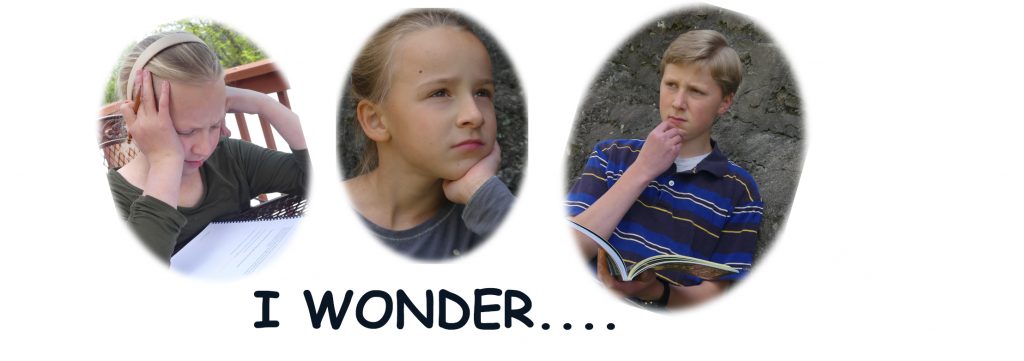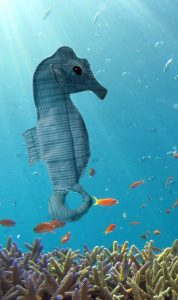
 A MARINE VACUUM CLEANER ?
A MARINE VACUUM CLEANER ?
Supplies needed:
A small hand vacuum, either battery or electric
Wiggle eyes—stick on kind, for face on vacuum (You can use double stick tape to help hold eyes on the vacuum, or
you may decide to place them on permanently. It might inspire a child to want to use the vacuum later. It’s a thought!)
Brightly colored paper torn into several small pieces Pictures of seahorses, one is given here, but a lot of them are available on line
Preparation
Make a face on your vacuum by applying eyes. The Mouth is the opening or the suction part of the vac.(You will understand that in a moment or two.)
Now you have a friendly vac named Victor who will help with the lesson.
Lesson intro
No clues are visible yet about seahorses, No pictures showing anywhere yet!
Holding up the vac that has a face:
“This is Victor. He is always hungry, and today we want to help feed him. Who would like to be first to feed him?” Volunteer takes vacuum. You turn around and sprinkle some of the torn paper all across the table and tell the child to start feeding Victor. Continue this process for a bit asking for other volunteers as needed. Then ask the questions. “When do you think Victor will not be hungry anymore? When do you think you can stop? When do you think Victor will be full?”
The answer is “Never” because he is so like the marine animal we are learning about today. And why would that be?
The marine vacuum we are learning about today is a seahorse. A seahorse must eat almost continuously because of the way it is made. And how does it eat? It is
designed to literally suck in its food like a vacuum. It has no teeth to chew and no stomach to help digest its food. It must suck it in, and it makes use of the food very quickly then it must have more! And More! And More! (You may want to turn on the vac again to make the point)
A seahorse can’t stop sucking in the food, or he will die. Why? It has no stomach. The food goes very quickly through the very small digestive parts that it has. It can and does benefit from its food, but not in ways most animals do. Because of that fact, it must eat almost constantly.
(At this point, you may want to display some pictures before continuing the lesson.)
Other interesting facts about seahorses
The seahorse is actually a fish, but many things about it are very different from other fish.
How do they eat? By sucking in their food. ( Like a vacuum cleaner!)
How often do they eat? Nearly constantly
ARE THEY GOOD SWIMMERS? No, they are not a fast swimmer, but they can maneuver well with their fins. To go up and down, they use their swim bladder. They have the ability to rise or lower themselves by adjusting the volume in the swim bladder. If the swim bladder becomes damaged and looses gas, the seahorse will fall to the sea floor and die.
BONY EXTERIOR—NOT SCALES
Their bodies are protected by a bony exterior that is very strong. The design of the tail of a seahorse is actually being studied as a model of tremendous strength. It may become a model for new robotic systems. The tail is made
in approximately 36 sections of little boxes of bone that decrease in size all down the tail. The fact that they are square, not round, makes it easier for them to wrap around and hold on to things, like seaweed, in order to watch and wait for its food to come along.
A seahorse has UNUSUAL EYES for a fish. Its eyes can move independently. They can swivel to watch from each side.
A seahorse can CHANGE COLORS to match its surroundings. It can do this almost instantly.
WHO GIVES BIRTH IN THE SEAHORSE FAMILY?
It is a Mom and Pop thing, but The Pop, or Dad, actually gives birth! The mother lays the eggs inside a pouch on the father. This is the only place on either of them that is not covered with bony armor. As babies develop, the inside of the pouch becomes similar to surrounding sea water preparing them to be out in the sea. After one or two months, the father expels the babies. The new seahorses are then on their own.
Application:
There are so many fascinating things to learn about these marine vacuum cleaners. Learning about seahorses can remind us of God’s fantastic design in all of nature.
One thing I’d like for us to think about again is how the seahorse must keep eating. How can that apply to us? To you? To me? No, we aren’t talking about eating food to stay alive or to be strong. We are talking about getting close to God and staying connected with Him in order to stay alive in our hearts and souls! And how do we do that? — By giving our hearts to God and deciding to live for Him
always. We must keep learning more about His Word and all it can do for us. We need to continually learn more, read more, go to church and learn more about living the way God wants us to live. It is not enough to just know about how He wants us to live. We need to do it! ALL the time, not just a quick snack occasionally. Remember the seahorse. He must eat continually! And so do we. Read your Bible!
Recommended Resources:
Answers in Genesis web site, look for these two articles: Magnificent Monsters, by Karina Altman, May 1, 2018 https://answersingenesis.org/aquatic-animals/ magnificent-monsters/
The Amazing Seahorse, by David Juhasz, Originally published in Creation, 16, no 3, June 1994 https://answersingenesis.org/aquatic-animals/the- amazing-seahorse/
